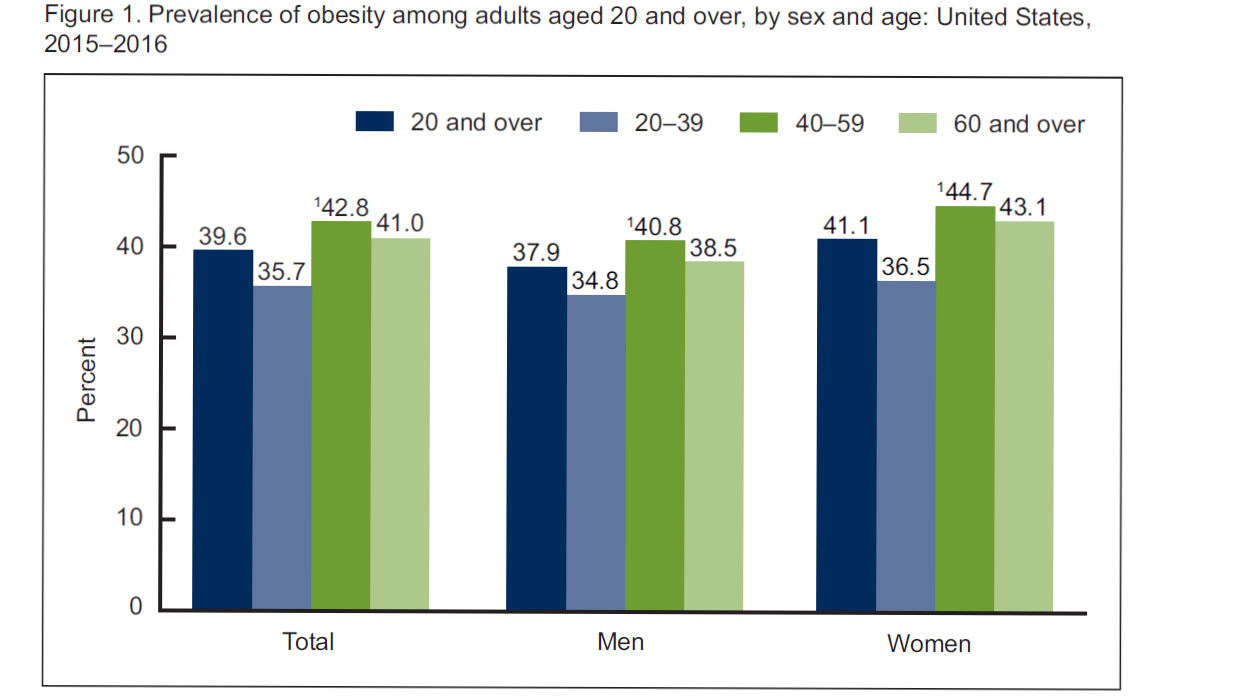Prevalence of Obesity Among Adults and Youth: United States, 2015–2016
Posted on by
Questions for Craig M. Hales, M.D., Lead Author on “Prevalence of Obesity Among Adults and Youth: United States, 2015–2016”
Q: There seems to be confusion about whether obesity is going up or is stable. Could you clarify based on your new data?
CH: The trends in obesity prevalence are different for adults 20 years and over than they are in youth 2-19 years. Since 1999-2000 there has been an increasing trend among adults. The prevalence of obesity was 30.5% among adults in 1999-2000 and has increased almost 10 percentage points to 39.6% in 2015-2016. Almost 4 in 10 adults had obesity in 2015-2016, and that is the highest prevalence of obesity ever reported among all US adults.
Among youth, there was a significant increase in obesity prevalence between 1999-2000 and 2015-2016, however, between 2003-2004 and 2013-2014 the prevalence was unchanged at 17% and there was no statistically significant change between 2013-2014 and 2015-2016. We are continuing to analyze trends in both youth and adults.
Q: Would it be accurate to say that, among adults at least, the percentage who have obesity hasn’t changed much in recent years, but has definitely increased over the past 10 or 15 years?
CH: The prevalence of obesity among adults has definitely increased since 1999-2000. Since 1999-2000 the prevalence has increased almost 10 percentage points from 30.5% to 39.6%, or almost 40%. From one 2-year cycle to the next, changes in obesity prevalence may appear small, but when we look over time, we are better able to see trends.
Q: Between adolescents, school-aged kids, and pre-schoolers, what are the most significant patterns among our youth, based on these new data?
CH: Among youth, these data show that school-aged kids and adolescents have a higher prevalence of obesity than pre-schoolers. This is the same pattern we have seen in previous reports from this survey.
Q: The U.S. has changed quite a bit demographically over the past 30 years, and this corresponds with large increases in the percentages who are obese. With obesity prevalence being significantly higher among U.S. Hispanics, would it be accurate to say that at least some of the increase in obesity prevalence in the U.S. is a characteristic of demographic change?
CH: It’s true that both non-Hispanic black and Hispanic adults have a higher prevalence than non-Hispanic whites and non-Hispanic Asians, although the patterns are different in men and women. Previous reports have found that trends over time are not explained by these demographic changes.
For this report we focused on a cross-section of the US population in 2015-2016, but we are continuing to analyze the data, including the impact of demographic changes on trends over time.
Q: What finding in your new report did you find most striking?
CH: What I found most striking is that almost 40% of adults in the US had obesity in 2015-2016. This is almost 10 percentage points higher than the prevalence was in 1999-2000. It is the highest prevalence of obesity ever reported among all US adults.
Q: What is the best advice for those who want to control their weight?
CH: I recommend that anyone who wants to lose weight talk to their healthcare provider. People can also learn more about US diet and physical activity guidelines at health.gov.
Q: Anything else you’d like to note about the new study?
CH: Measured height and weight is the gold standard for generating accurate estimates of obesity prevalence. The National Health and Nutrition Examination Survey is unique in that it combines both interviews in the home and physical examinations in mobile examination centers, and it is the only national survey where people’s height and weight are physically measured.
Other surveys report obesity prevalence based on self-reported height and weight, but several studies have found serious inaccuracies with self-reported or proxy-reported height and weight. Among adults and teens, self-reported height tends to be overreported and weight is underreported, although misreporting can vary among subgroups of the population – but this misreporting leads to underestimates of obesity prevalence.
Posted on by

